Park Electrochemical Corp. manufactures a complete line of reliable, high-value substrates for commercial and military critical microwave components, antennas and subassemblies. Their new non-PTFE resin system, Mercurywave™ 9350 (Mercurywave is a trademark of Park Electrochemical Corp.), is tailored to meet the needs of the RF and microwave market. With its low loss electrical properties and high thermal reliability, it offers greater flexibility and freedom to design high performance RF and microwave substrates. Mercurywave 9350 provides the electrical performance of a RF microwave material, but processes like an epoxy.
The Mercurywave 9350 laminate and prepregs have well controlled electrical properties with a Dk of 3.5 at 10 GHz by stripline. Figure 1 shows Dk versus frequency from 2 to 10 GHz demonstrating stability across the entire frequency range. It has a Df of 0.004 at 10 GHz by stripline; Figure 2 shows stable Df across the same 2 to 10 GHz frequency range. This electrical performance is also stable over temperature from -40° to 80°C, as shown in Figure 3, and at 24 hr humidity saturation testing from 25 to 85 percent RH, as shown in Figure 4.

Figure 1 Dk vs. frequency by stripline.

Figure 2 Df vs. frequency by stripline.
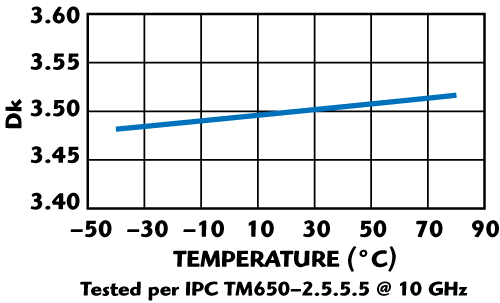
Figure 3 Dk vs. temperature.
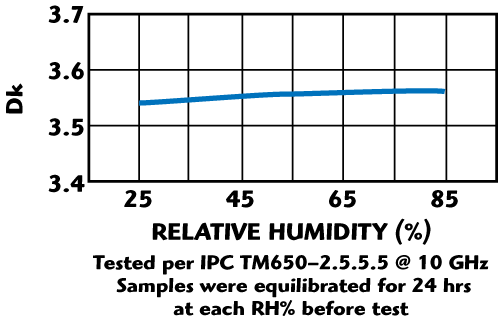
Figure 4 Dk vs. humidity @ 25°C.
The thermal and mechanical properties are also advantageous for RF and microwave applications. Mercurywave 9350 has a high Tg of greater than 200°C by Dynamic Mechanical Analysis (DMA) and low coefficient of thermal expansion (CTE) of 2.5 percent from 50° to 260°C. The CTE in the X/Y direction is 10-14 ppm/°C from -40° to 125°C. The low Z-axis CTE provides excellent plated through hole quality even under extreme temperature changes. It is compatible with lead free processing withstanding multiple 260°C reflows. Mercurywave 9350 has a high peel strength of 7 lbs/in (1.23 N/mm) using Reverse Treated Foil copper for adhesion and which also provides for a very low loss contribution by the copper. It is compatible with alternative oxide and ENIG/immersion tin plating chemistries. Mercurywave 9350 does not require any special fabrication techniques or special surface roughness requirement for solder mask adhesion. Standard hole wall preparation can be used as no sodium etchant or plasma treatment is needed. The material is capable of v-score singulation and meets/exceeds IPC 4103/11 electrical and mechanical requirements. Table 1 summarizes its thermal properties.
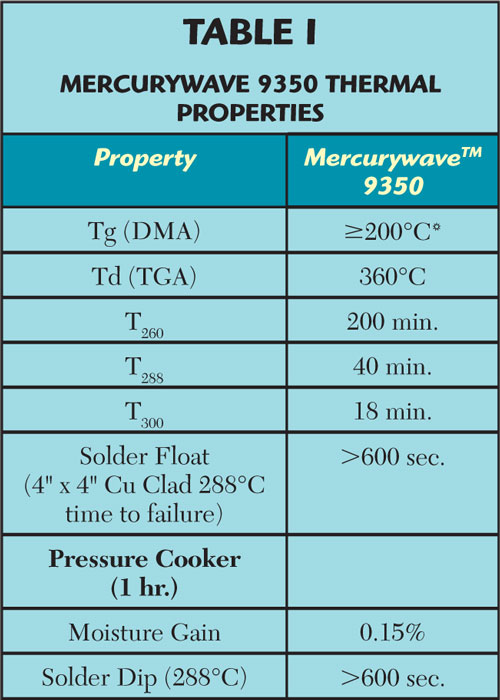
Mercurywave 9350 RTF has better insertion loss than competing materials. Figure 5 shows the insertion loss versus frequency for a 130" meanderline trace comparison for a WiMAX antenna application operating at 3 GHz. The Mercurywave 9350 RTF shows a 1.2 dB improvement in insertion loss at 3 GHz over Mercurywave 9350 using DFF (Dual Flat Foil). It also has the capability to flow and fill PCBs requiring buried via designs (see Figure 6).
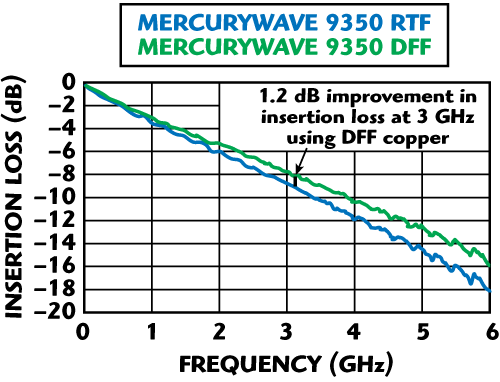
Figure 5 130" meanderline trace comparison (insertion loss) of WiMAX antenna application operating at 3 GHz.
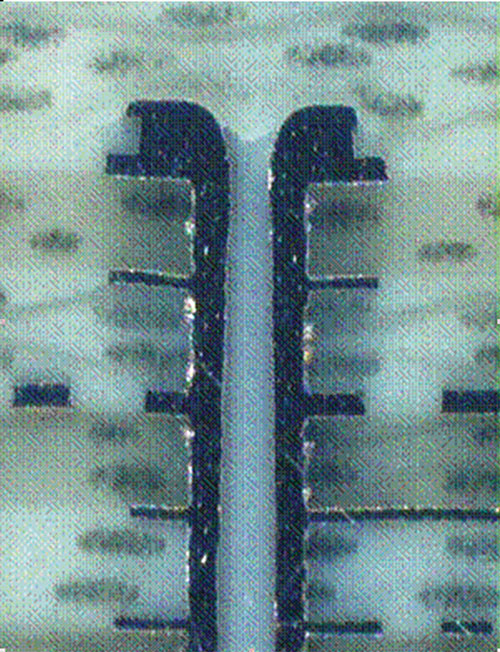
Figure 6 Buried via cross-section.
Mercurywave 9350 is available in a range of core thicknesses of 0.003" (0.076 mm) and up. Multiple panel sizes are available and prepregs for multilayer lamination (106 and 1080 prepregs). Potential applications include various base station equipment (PAs, filters, combiners, etc.), automotive (radar, communications, road tolling), satellite communications (LNBs, LNAs, GPS), military (communications, guidance systems, radar) and broadband antennas (WiFi, WiMAX, RFID, LANs).
Park Electrochemical Corp.
Melville, NY (631) 465-3600
www.parkelectro.com
RS No. 302
